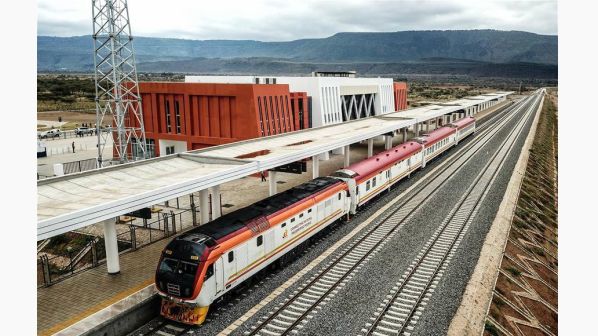As the festive season approaches, thousands of Kenyans will rely on the Standard Gauge Railway (SGR), a modern transport solution connecting Mombasa, Nairobi and beyond. Since its inauguration in 2017, the SGR has evolved into a critical part of Kenya’s infrastructure, offering a reliable and efficient means of transport for both passengers and cargo. Amid criticism, particularly regarding its financing, the project’s impact on Kenya’s socio-economic landscape is undeniable in transforming livelihoods and enhancing regional connectivity.
One of the key advantages of the SGR is its ability to significantly improve passenger transport. Since its launch, the Madaraka Express, which is part of the SGR network, has carried over 12.1 million passengers. This represents a dramatic improvement in Kenya’s travel options, providing a fast and safe alternative to road travel.
The SGR offers a smooth, comfortable ride from Nairobi to Mombasa in approximately five hours, significantly reducing the travel time compared to the 10-hour road journey. During the holiday season, when road traffic is particularly congested and risky, the SGR is the preferred choice for many families and travellers. By alleviating pressure on the country’s overburdened roads, the SGR offers a much-needed solution to Kenya’s transport challenges.
Since its inception, the railway has moved over 29.7 million tonnes of freight, transforming the country’s logistics sector. By providing a cost-effective and efficient mode of cargo transport, the railway has reduced reliance on road transport, which often leads to delays, high costs and security concerns. Industries that rely on the timely delivery of goods, such as agriculture and manufacturing, have benefited greatly from the SGR’s improved logistical capacity.
Beyond improving transport efficiency, the SGR has had a direct positive impact on Kenya’s economy. More than 2,000 people are employed directly by the railway, with many more benefiting from the opportunities it has created in sectors like hospitality, retail and logistics. Small towns and businesses along the railway route have thrived as a result of the increased movement of people and goods.
The ripple effect of the SGR’s operations is evident in the growth of local economies and the creation of new business opportunities. During its construction, the SGR also provided a boost to local industries such as cement, steel and construction services, further strengthening the country’s industrial capacity.
The SGR’s role in regional integration is another critical aspect of its impact. The ongoing expansion of the railway to Kisumu and plans for further extensions into Uganda and beyond highlight the broader economic vision behind the project. This extension will open up trade corridors and create new opportunities for economic collaboration within East Africa.
The development of the railway is in line with the African Continental Free Trade Area (AfCFTA), which aims to reduce barriers to trade and foster intra-African commerce. This will ultimately benefit the Kenyan economy by facilitating smoother trade and providing access to regional markets, which are expected to grow significantly in the coming years.
Environmental sustainability is another area where the SGR has made a positive impact. Trains are far more energy-efficient and environmentally friendly than trucks, and the shift to rail transport has helped reduce the carbon footprint associated with road-based freight. By moving a significant amount of goods from roads to rail, the SGR is contributing to Kenya’s efforts to mitigate climate change.
From a social perspective, the SGR has enhanced safety for both passengers and cargo. Road accidents and the theft of cargo have long been major challenges in Kenya, and the SGR offers a safer alternative. The railway is heavily monitored, reducing the likelihood of criminal activity, and it has created safer conditions for transport workers and passengers alike.
Despite the numerous benefits that the Standard Gauge Railway (SGR) has brought to Kenya, it has faced criticism, particularly concerning its financing. A major source of these concerns is the fact that the project was funded through loans from China, leading some critics to question Kenya’s ability to manage the debt associated with the railway. However, such accusations overlook the thorough due diligence that was conducted during the planning and financing stages of the project.
The SGR financing followed a well-established process, including the involvement of financial institutions and international experts to ensure the project’s viability. The Kenyan government, in collaboration with Chinese contractors and lenders, engaged in a detailed financial analysis, which assessed the economic impact of the railway and its long-term sustainability. This process was not only in line with international standards but also involved careful scrutiny of the expected returns from the project.
Furthermore, Kenya’s debt management strategies include clear repayment plans, and the SGR project is designed to be self-sustaining. The increase in freight volumes and the projected expansion of services are expected to improve revenue streams, making the project financially viable in the long term. The government has also taken measures to ensure the efficient use of the funds, prioritising strategic investments that will contribute to the country’s broader economic growth.
It is important to acknowledge that large-scale infrastructure projects such as the SGR typically involve significant upfront costs. However, these investments are seen as critical to long-term development, and many similar projects around the world are funded through loans. The SGR is not an exception but rather a model for infrastructure projects that seek to generate returns over time, positioning Kenya as a regional economic powerhouse.





